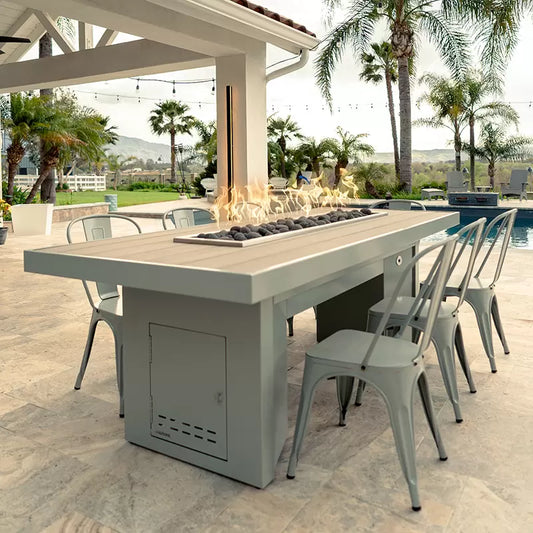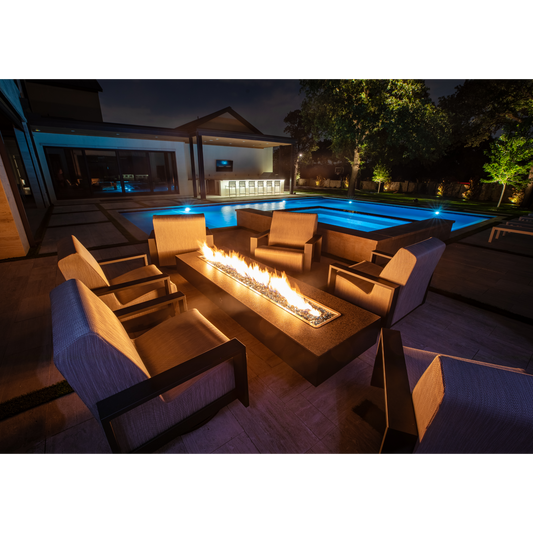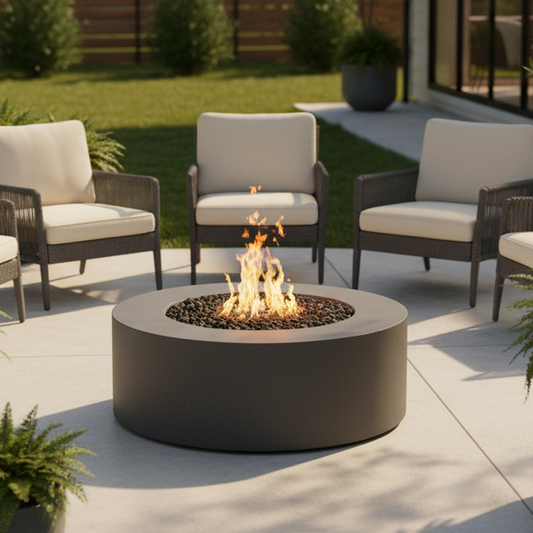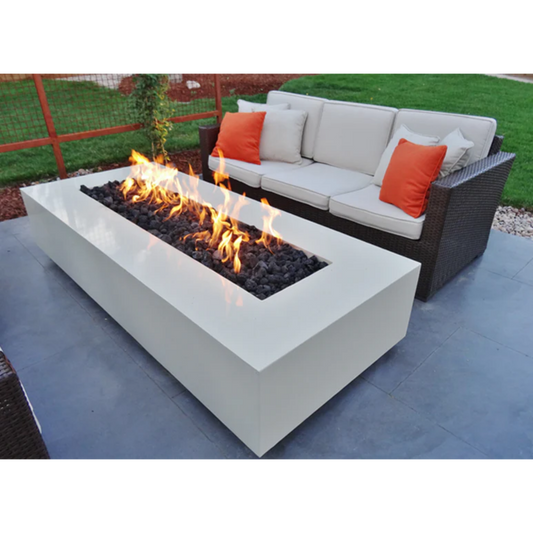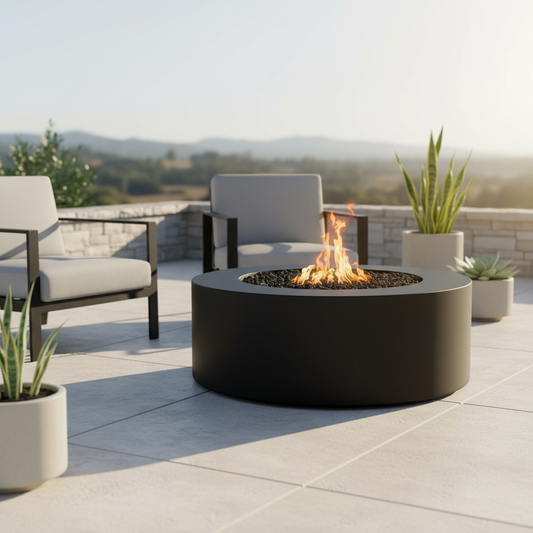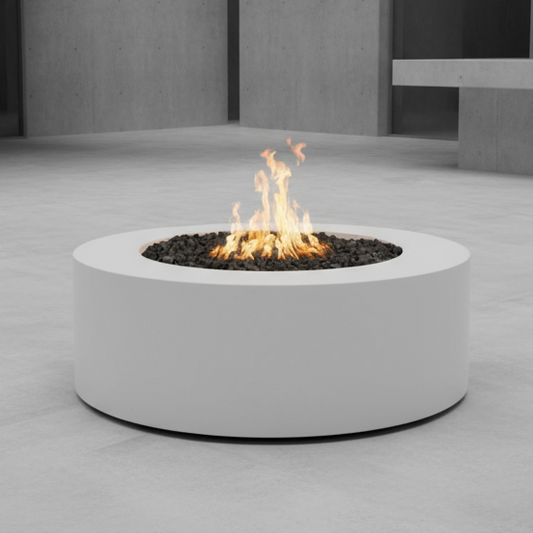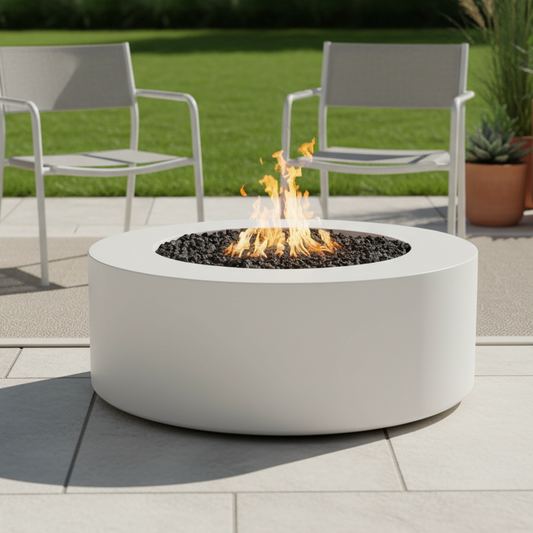Ventilation & Carbon Monoxide: Outdoor vs Covered Spaces

Share
Quick Summary
-
Open-air patios (no roof or walls): generally safe for gas fire features when other clearances are met.
-
Semi-covered spaces (pergolas, pavilions, 1–2 walls): conditionally safe only with two or more open sides, strong cross-ventilation, and manufacturer clearances.
-
Fully enclosed spaces (garages, sunrooms, tents): do not use gas fire features—risk of carbon monoxide buildup.
-
CO detectors read in ppm; treat any alarm or persistent odor/headache symptoms as a stop signal.
- Use our Ventilation Safety Pyramid (Openness × Airflow × Duration) + the printable checklist below.
- For the broader safety ecosystem (distances, decks, trees, extinguishing, troubleshooting), start here Fire Pit & Fire Pit Table Safety (U.S. Homeowner Guide)
1. Introduction: Why ventilation matters
If you’re planning to enjoy a gas or propane fire feature on a covered patio, under a pergola, or inside a gazebo, the big question is simple: Do I have enough airflow to avoid carbon monoxide (CO) buildup? CO is odorless and invisible; good ventilation disperses it before it accumulates. In this guide, you’ll get a clear yes/no framework, what counts as “open enough,” how to measure openings, and easy add-ons (like wind guards and deflectors) that support safety without replacing manufacturer clearance and ventilation requirements.
For house distance, decks, trees, and other proximity topics, follow the links we’ve placed throughout this page.
2. Quick Answer: When it’s safe vs unsafe
In practice, spaces fall into three buckets:

Open-Air (Ideal)
Patios or yards with no roof and no walls. Natural wind and air exchange disperse combustion byproducts efficiently.
Semi-Covered (Conditional)
Pergolas, pavilions, or roofed structures with at least two fully open sides. Good cross-breeze is required; more openness is better.
Enclosed (Prohibited)
Garages, tents, sunrooms, screened porches with limited airflow, or spaces with three or four sides enclosed. These can trap exhaust gases—don’t use gas fire features here.
Ventilation Comparison (Quick View)
|
Space Type |
Typical Example |
Airflow Need |
Safe to Use?* |
Notes |
|
Open Patio |
Backyard with no roof/walls |
Natural airflow |
✅ Generally acceptable |
Still respect all clearances & local rules |
|
Pergola / Pavilion |
Slatted roof, 2–4 posts |
≥2 open sides; strong cross-ventilation |
⚠️ Conditional |
Add wind guard, keep burn sessions shorter |
|
Covered Patio w/ 1 Wall |
Roof + one solid wall |
Large opposite opening for cross-flow |
⚠️ Conditional |
Monitor for odors/headaches; keep a CO detector |
|
Screened Porch / 3 Sides |
Mesh walls, limited gaps |
Airflow often inadequate |
❌ Not recommended |
Move to open area |
|
Garage / Sunroom / Tent |
Fully or tightly enclosed |
Insufficient |
🚫 Prohibited |
CO hazard—do not use |
*Always follow the most restrictive of: manufacturer manual, label, and local code/HOA.
3. The Ventilation Safety Pyramid (Unique Framework)
Think of safe operation as a pyramid with three layers you must satisfy:
- Openness
- More exposed sides = safer. Aim for two or more fully open sides on semi-covered structures. Curtains/screens block cross-flow; open or remove them during operation.
- More exposed sides = safer. Aim for two or more fully open sides on semi-covered structures. Curtains/screens block cross-flow; open or remove them during operation.
- Airflow
- Create a path: intake on one side, exhaust out the other. Orient the burner so the flame and exhaust don’t face a wall or heavy drape.
- Maintain a vertical exhaust path above the flame; don’t place the unit beneath a low soffit or dense shade cloth. (See pergola clearances below.)
- Create a path: intake on one side, exhaust out the other. Orient the burner so the flame and exhaust don’t face a wall or heavy drape.
- Duration
- The longer you burn, the more ventilation you need. On marginal setups (e.g., one wall), run shorter sessions, then let the area air out.
- The longer you burn, the more ventilation you need. On marginal setups (e.g., one wall), run shorter sessions, then let the area air out.
Accessories like wind guards and heat deflectors help stabilize the flame and manage heat direction, but they do not reduce required clearances or ventilation in the manual.
4. Understanding CO, detectors & “ppm” talk (plain-English)
- CO forms when fuel doesn’t fully combust. Gas and propane units are designed for clean burning, but wind, poor airflow, or blocked burners can increase CO output.
- CO detectors display parts per million (ppm) and may include short-term exposure limit (STEL) alarms. If your detector alarms or shows sustained readings higher than its informational thresholds, shut down immediately and increase ventilation.
- Outdoors, background CO is usually low compared with typical indoor issues—but semi-covered or enclosed layouts can concentrate gases.
- Symptoms can include headache, dizziness, fatigue—treat these as a stop signal.
If you’ve seen queries like “carbon monoxide ppm safe levels,” “what are normal carbon monoxide levels in a house,” or “is 20/50 ppm carbon monoxide dangerous,” the takeaway is this: don’t chase numbers. Use a reliable detector, follow your manual and local code, and treat any alarm as a firm stop.
5. How to measure openings & clearances in covered spaces
Goal: keep enough open sky and cross-flow for exhaust gases to escape.
-
Open-side rule: Keep two or more sides open from floor to roofline. As a rule of thumb, target full-height openings at least 6–8 ft (1.8–2.4 m) wide on opposite sides for cross-flow.
-
Vertical path: Maintain the manual’s vertical clearance to any overhead beam, soffit, or fabric. If not specified, take a conservative approach and keep 12 ft (3.7 m) or more of open air above the flame zone, then verify with manufacturer guidance.
-
Measure correctly: Measure from the burner centerline, not the outer edge of the housing.
- Obstacle scan: Watch for heaters, ceiling fans, light fixtures, or drapes in the exhaust path—these interrupt airflow and can heat-soak.

If overhead clearance is tight or you’re using awnings/fabric, jump to: Pergolas, Awnings & Covered Structures: Clearance Rules for Fire Pit Tables
6. Enhancing ventilation & comfort (without breaking the rules)
-
Wind guard: Stabilizes the flame so it burns cleaner and reduces lateral flicker into posts or screens.
-
Heat deflector: Redirects heat upward; may improve comfort beneath a roof, but it doesn’t change required clearances.
-
Keep openings high: Try to maintain open space ≥ 3 ft (0.9 m) above the flame so warm gases can rise and escape.
-
Avoid box-in: Don’t surround the burner with glass on all four sides in marginal ventilation areas.
-
Session length: In semi-covered spaces, run shorter sessions and let the space air out between burns.
7. Problem/Solution mini-cases
Case 1 — Weak flame & “stuffy” feel under a covered patio
Problem: Flame sputters; guests report a mild odor or discomfort.
Likely causes: Trapped exhaust, insufficient intake airflow, or wind eddies.
Fixes:
- Open two opposite sides fully for cross-flow.
- Rotate the unit so the exhaust doesn’t face a wall or curtain.
- Add a wind guard and reduce flame height one setting.
- Shorten session duration; between sessions, air out the space.
- If you have a detector and it alarms, shut off immediately.
Case 2 — Headaches after use inside a screened porch
Problem: Users report headaches or fatigue after 30–45 minutes.
Likely cause: CO concentration from three-sided enclosure.
Fixes:
- Move the unit outdoors or to a fully open pergola with strong cross-ventilation.
- Install an outdoor-rated CO detector near the seating zone.
- Review clearances and burner cleanliness (blocked ports hamper combustion).
- For surface and distance questions, see How Far Should a Fire Pit (or Table) Be From the House? and Deck Safety – Wood, Composite & Stone Decks.
8. Ventilation Safety Checklist (Printable)
CHECKLIST: Ventilation safety pre-check – openings, airflow direction, detector placement
- ☐ My space is open air or has ≥2 fully open sides from floor to roofline.
- ☐ The vertical path above the flame is clear; overhead clearance matches my manual.
- ☐ I’ve created a cross-ventilation path (intake and exhaust on opposite sides).
- ☐ No fabric curtains, shade sails, or screens are drooping into the plume.
- ☐ A CO detector is present and functioning (replace batteries per schedule).
- ☐ Burn sessions are moderate in length; we air out the area between sessions.
- ☐ I’ve reviewed manufacturer instructions and local code/HOA rules.
- ☐ Extinguishing steps and a lid are handy. (Need help? How to Extinguish a Gas or Propane Fire Pit Safely)
9. Link to other guides
- Distances to walls/doors/windows? → How Far Should a Fire Pit (or Table) Be From the House?
- Deck surface questions? → Deck Safety – Wood, Composite & Stone Decks
- Pergola/awning clearances? → Pergolas, Awnings & Covered Structures: Clearance Rules for Fire Pit Tables
- Trees, fences, pools nearby? → Trees, Fences & Pools: Safe Distances
10. FAQs
-
Q1: Can you use a gas fire pit under a covered patio?
A: Only if the space has strong cross-ventilation (≥2 open sides) and you meet all manufacturer clearances. If the area feels stuffy or a detector alarms, shut down and move to a more open layout. -
Q2: Do outdoor fire pits produce carbon monoxide?
A: Yes—any flame can. Outdoors it disperses quickly, but semi-covered or enclosed spaces can concentrate it. That’s why openness and airflow matter. -
Q3: What about “carbon monoxide ppm safe levels” I see online?
A: Use a reliable detector and follow the alarm guidance in its manual. Don’t chase specific ppm targets; openness + airflow are your primary controls. -
Q4: Are “normal carbon monoxide levels in a house” relevant to patios?
A: Indoor guidance is about enclosed spaces. Your goal outside is preventing buildup—maintain open sides, vertical exhaust, and shorter sessions in marginal layouts. -
Q5: Is 20 ppm or 50 ppm carbon monoxide dangerous?
A: Treat any detector alarm or persistent readings with caution: shut down, improve airflow, and relocate if needed. When in doubt, move fully outdoors. -
Q6: Do wind guards help with CO?
A: Indirectly. They stabilize the flame, which supports cleaner burning—but they do not replace ventilation or reduce required clearances. -
Q7: Should I use a CO detector on a pergola?
A: It’s a smart backup in semi-covered spaces. Place it near seating and test it regularly.
11. Conclusion & Next Steps
Safe use of gas fire features in covered areas is all about airflow. If you can’t guarantee two open sides, clear vertical exhaust, and manufacturer-approved clearances, relocate your setup to a fully open patio. Keep sessions moderate, monitor comfort, and let a CO detector be your impartial referee.
- Explore certified models and accessories: Fire Pit Table Collection
- Add safety gear: Accessories – Wind Guards, Deflectors & Vent Kits
- Need tailored help? Contact a Specialist

